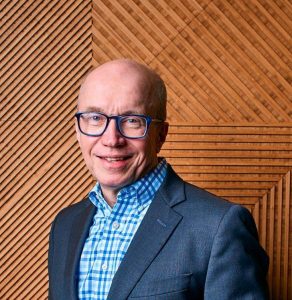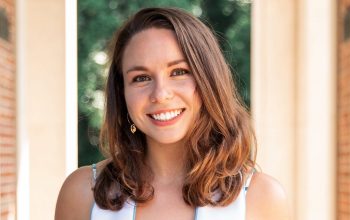The Catalyze podcast: Alan Murray ’77 of Fortune on political polarization, growing revenue streams in media, & the future of work

Alan Murray ’77 is CEO of Fortune Media.
Prior to joining the media organization in 2015, Alan served as president of the Pew Research Center in Washington, D.C. For nearly two decades, he held a number of roles at The Wall Street Journal, including deputy managing editor, executive editor online, and the Washington bureau chief. Alan also served as the Washington bureau chief at CNBC and as a cohost of the nightly show Capital Report.
More about Alan
Following his graduation from the University of North Carolina at Chapel Hill, Alan moved to Tennessee to edit the business and economics sections for the Chattanooga Times Free Press. (The alumnus was nominated for the Morehead-Cain Scholarship by the Chattanooga-based Baylor School.)
In 1980, he began reporting for the Congressional Quarterly in Washington, D.C., and the Japan Economic Journal in Tokyo a year later, after earning a Luce Scholarship.
Alan earned his undergraduate degree in English literature from Carolina and a master’s degree from the London School of Economics. In 2005, he completed the Stanford Executive Program (SEP) through the Stanford Graduate School of Business.
Alan resides in Greenwich, Connecticut, with his wife, Lori.
On your mobile device, you can listen and subscribe to Catalyze on Apple Podcasts or Spotify. For any other podcast app, you can find the show using our RSS feed.
Catalyze is hosted and produced by Sarah O’Carroll for the Morehead-Cain Foundation, home of the first merit scholarship program in the United States and located at the University of North Carolina at Chapel Hill. You can let us know what you thought of the episode by finding us on Twitter or Instagram at @moreheadcain or you can email us at communications@moreheadcain.org.
Episode Transcription
(Sarah)
I saw on your LinkedIn that you’ve been a journalist since the age of nine. What does that mean?
(Alan)
So, when I was nine years old, I was compelled to walk up and down the street in the neighborhood where I lived and ask people about what was going on in their lives. You know, their grandmother was visiting, they’d lost their cat, they won the swim meet.
I took notes and then went home and wrote it all up in a newsletter. My mother would type it up using a special carbon paper, and then I had this jelly sheet printer, so I could take the carbon copy and put it on the printer, and then run off about thirty copies of it. And I sold them in the neighborhood for five cents. So that’s what it means.
It’s always kind of bothered me, particularly when I was at Carolina. I think I went through a period where it bothered me that my career had been determined before I was really old enough to make an intelligent decision.
And for a while I said, “You know what? I’m not going to be a journalist. I’m going to go to law school. I’m going to do something completely different.” But I finally gave in to the urge. It’s clearly what I was destined to do.
(Sarah)
Did you grow up in a family of journalists as well, or where else do you think that came from?
(Alan)
Not at all. I have no idea. I did not grow up in a family of journalists. My father worked for Westinghouse and was in sales. I have no idea where it came from. What I can say in retrospect, putting a rationale on it after the fact, is what’s great about being a journalist is that you are constantly learning new things. Constantly. You’re thrown into situations where you have to learn new things. And I love that, and I’ve loved it my entire life.
And even when I’ve been in predominantly management roles, as I am now, I have clung to a piece of my journalism existence for precisely that reason. It just, it keeps you curious and focused and interested in what’s going on in the world, and makes you try and distill it into concise and clear words.
(Sarah)
Now, you studied English literature at Carolina. Can you tell us about that experience, knowing you were interested in journalism?
(Alan)
Yeah, I thought about majoring in journalism. I took a few journalism courses, but by that time I had done a lot of journalism in the world. And in the first journalism course I took, they asked me to write a story for the teacher, and I thought, I don’t want to write a story for a teacher. I write stories for people. And so I pretty quickly got frustrated with the notion of learning journalism in a classroom and changed my major to English literature, which I loved.
And by the way, for a while, when asked by young journalists whether they should major in journalism, I used to advise them not to. But my opinion on that has changed in recent years because the practice of journalism has become so much more complicated than it used to be, and requires so many more technical skills.
The best journalists today come out understanding how to shoot a video and edit a video on their own and understanding, if not how to write code, at least how code works, and how to build an audience over social media. There’s just so much more to journalism in the digital world than there was in the print world that I think the argument for journalism education is stronger than it used to be.
(Sarah)
So you seem to have had a traditional path in journalism where, after graduating, you returned to Chattanooga, Tennessee, the city where you attended high school, to serve as an editor to the Chattanooga Times Free Press. I wanted to ask whether you miss being as close to your readers as you were at the start of your career, and how you’ve redefined community in the roles you’ve had since, particularly now at Fortune.
(Alan)
I love that question, Sarah, and I thank you for asking it. I don’t think anyone’s asked me that before. Look, I believe community is at the core of journalism. You have to understand you don’t write the same way for everyone. You have to understand who you’re writing for.
And in the old days, when community was defined by geography, you sort of understood that. But I still write for communities. I mean, I do a newsletter called The CEO Daily. I write three hundred words for the top of it every weekday. And it’s sort of how I cling to sanity, and it lets me do the management parts of my job that follow.
And that’s a very, very clear and satisfying community. I hear from those readers. Dozens of them respond to me every day. I respond back. They know how I view the world. They let me know how they view the world. To me, that’s a big part of the fun of journalism and has become much, much more common in the digital world than it was in the print world. It’s just that the communities are defined differently, whereas they were defined by geography in the past, they’re now defined by communities of interest.
(Sarah)
I think in this age where attention spans are as short as a TikTok, there’s still such a strong readership out there for newsletters, for example, and that gives me some confidence that people still want good information. They’re just consuming it in very different ways.
(Alan)
Look, it’s good and it’s bad. People seek out the kind of information that they need. And so I love my readers, and I know what their interests are, and I know how to feed them every day. But what’s lost is any sort of common factual basis for discussion, dinner table conversation, or democracy.
We’re in the middle of a great example of that right now. Even some of my newsletter readers, I can’t believe the things they say about fraud in the last election, but there’s no evidence of that. Every state in the country, whether it was under Democratic or Republican leadership, certified the election results. And every court that was asked to consider fraud came to the conclusion that there was no fraud of a significant enough scale to make any difference in the election. It all seems so clear to me on a factual basis, and yet a huge portion of the American population believes something very, very different. So we don’t know what we’ve lost.
What we’ve gained in journalism is the creation of these tight communities. That’s very satisfying, where you’re writing for people who know you, and believe in you, and you share ideas. But what we’ve lost is any sort of basis for public discourse.We just don’t agree on the basic, most basic facts of our lives and national existence, which is disturbing.
(Sarah)
Well, in addition to polarization, I think if we were hashing out the history of mass media, I think our current era would also be in part defined by disinformation. Now, Fortune has the great benefit of having a name and a reputation. But the downside, it seems, is the same for everybody else in that the outlet also has to fight this jungle of information and misinformation and people’s streams and feeds. How does Fortune stand out and leverage that name recognition amidst this just thicket of noise?
(Alan)
It’s a great and complicated question. And I do think the world has changed so much. When I graduated from Carolina and first started to work at what was then the Chattanooga Times, the national news in particular really came from a pretty small number of people. There was the Associated Press, there was the United Press, there were a handful of big newspapers that had sizable Washington bureaus, and there were the three networks.
It was a pretty common source of information that everybody was reading wherever they were. And of course, the critique of that was that those people, they thought too much alike. You know, they spent too much time having lunch together, and they saw the world in similar ways. And I think that’s probably true. And there were probably some biases in the way they approach the news. But at least you had some common framework to discuss.
That’s just gone. That’s gone. I read The New York Times every morning, but I’m well aware that half the country doesn’t believe anything they read in The New York Times. I think it’s a shame, not because I think The New York Times doesn’t have biases inherent in its structure. I think it does. But it also has a pretty rigorous culture of fact checking, error correcting, seeking out multiple sides to a story, things like that, that assure better information than the posts that show up on Facebook that may well be from a Russian troll farm. I think we’re in a very tough place.
It’s a little different in business news. And I felt this when I was at the Wall Street Journal, where I spent most of my career, because business news readers are often reading to find information on which they will make bets. They put money on the line so they really can’t afford to be dealing with distorted information. They have to have good information because they’re putting their money on it. And so I think that’s kept the business press a little more on the straight and narrow than the general press, but it’s affected all of us.
(Sarah)
We’ll be right back. Stay with us.
If you’re interested in hearing more from Alan, you’ll want to join us for his Virtual Alumni Speaker Series event coming up on Wednesday, January 27. Alan will talk about restoring trust in America. His talk starts at 4:00 p.m. Eastern Time. And you can find more information on the Morehead-Cain Network.
(Sarah)
You mentioned your time at The Wall Street Journal, where you worked for almost two decades. Did you know Neil Budde?
(Alan)
Yeah, of course. I know Neil very well. Is he a friend?
(Sarah)
Well, my father was a reporter at the time and used to bump into him a lot at conferences in the nineties. So I thought there might have been some crossover for when you were at WSJ.
(Alan)
Yeah, yeah. No, good guy.
(Sarah)
So, as you know, Neil was a pioneer for digital-first news, and he was right. But going digital is in part how content turned into a commodity, where people aren’t all that willing to pay for it. And yet The Wall Street Journal was among the first to take the counter view that the information they have is valuable, it should be protected, and it should have a cost. I wanted to ask what that conversation looks like at Fortune, and how you decide what to charge, and what should be free, and what premium subscriptions or tiers of memberships should look like.
(Alan)
The Wall Street Journal as a business over the last twenty, thirty years has made plenty of bad decisions, but it made one really good decision. And that was made by the chairman, Peter Kann, who said, “We’re not going to give our content away for free, period.” Really, it was the only major news publication that did that, and it was the right thing. And now everybody else has spent the last five years scrambling to catch up.
Look, the the harsh reality is that the advertising model that worked for community newspapers when I started my career doesn’t work for digital journalism. There are sites that make money, but they by and large, they tend to do it mostly by relying on aggregated content, stuff that has showed up someplace else that they rewrite or they do it by user-generated content, stuff that’s given to them. That’s the Facebook model, obviously, given to them for free by somebody who’s participating on the platform.
But deeply reported journalism in a digital world, it’s just very hard to support with advertising because the advertising is all going to Facebook and Google, and increasingly Amazon and Apple. There’s just not enough money left over to support good journalism.
So I think it’s maybe unfortunate but inevitable that news organizations have to turn to the subscription model. I agree with the way you described it, which is it’s tough. It’s been very tough for Fortune. We launched our paywall about a year ago, and it’s been a tough struggle getting people to pay for something that has been free to them for so long. But it’s a struggle that you have to do because you can’t produce good journalism otherwise.
(Sarah)
It seems like your position seems to demand to focus on growing and nourishing a whole host of different revenue streams. Is that something that occupies your work life to a large extent in thinking about how to monetize what Fortune brings to the table through conferences or other sorts of programming?
(Alan)
Yeah, absolutely. We’ve had a complicated ownership history over the last four years. We were part of Time Inc., which is twenty-four different magazines. Time Inc. was sold to Meredith, which also published magazines. And then Meredith made the decision to sell Time, Fortune, Money, Sports Illustrated. So when we were at Time Inc., we were unique among the twenty-four magazines in that we had developed this really nice, separate revenue stream in our executive conference business.
By last year, we were getting more than a third, close to 40 percent of our revenue from executive conferences, and that gave us a cushion that a lot of other magazines didn’t have, all the twenty-three other Time magazines. At the time I left a couple of years ago, they were still getting 70 percent of their revenue from print, and that’s just not a sustainable situation. Print was declining. Print revenues were declining steadily every year. So we had this nice conference business, and then what we’ve been doing since we gained our independence (we were bought by a Thai businessman two years ago) is looking for other revenue streams.
The most exciting thing we’ve done recently is to launch Fortune Connect, which grew out of our conference business and is a platform for training the next generation of business leaders, which I’m really excited about. Hope we have some time to talk about it.
(Sarah)
I would love to hear more about that. So tell us how you’re thinking that program will expand in the year ahead, and the sort of audience you’re looking at, and what you hope they get most out of it?
(Alan)
Well, it is a digital transformation story. We ran these successful, profitable conferences, mostly attended by CEOs and very, very senior business leaders. We had our Most Powerful Women conference. We had our Fortune Brainstorm Tech, the Fortune Global Forum.
But I began to notice, what the top executives who attended those events were telling me was, “This is great. We love it. It’s a great way to keep up with what’s going on in the business world. Change is happening so fast. We need these events to share ideas. And you guys do a good job putting them on and focusing on the latest trends and developments. But the real need for this is not at my level. The CEO level of the C-suite level. It’s about two or three levels below that.”
And I heard this story repeatedly from different industries, [that] the best people in their companies mastered their business. But at some point, they reached a level where they really needed to understand the business world more broadly. And that was where the need was.
And the design problem for us is, well, great. But that’s thousands and thousands of people. And they’re not going to pay the kind of money that our CEOs pay to come to an event at The Ritz-Carlton, Laguna Niguel, overlooking the Pacific Ocean, with lots of fabulous food in the process. And so, how do we scale this conference business so that we can serve that larger audience? And the pandemic forced us to learn that lesson.
We had never done a virtual conference before March 12. We’ve done more than a hundred of them since March 12. We’ve learned the power of digital platforms in creating communities, back to your original discussion about communities. And it gave us the design breakthrough we needed to launch Fortune Connect. And we now have 1200 executives who are Fortune Connect fellows. They’re from some of the biggest and best companies in the world: Salesforce, Workday, Accenture, IBM, Genpact, Royal Bank of Canada.
It’s really a great, global group. And we’ve basically told them, “Give us the people who you think have a shot of being in your C-suite ten or fifteen years down the road, and we will begin to introduce them to the principles of modern business, how technology is going to change their business, the value of purpose-driven leadership, the rise of stakeholder capitalism, which forces them to look not just at their shareholders, but at a broader group of stakeholders. It’s really exciting, and it’s growing very rapidly, and we think it’s going to be a big, big part of the future at Fortune.
(Sarah)
Well, very exciting to hear. Also, in speaking of just the changes the pandemic has resulted in, I wanted to ask: you used to commute from Greenwich, Connecticut, to Manhattan. Do you miss the commute?
(Alan)
No, no, not at all. Look, offices create culture. We moved out of the tiny Manhattan offices with twenty-four other publications where everything was siloed in October 2019 into our own offices in Lower Manhattan. And it was great for six months. It was glorious. I mean, the fact that the Fortune team was all together and not split up into different departments, and we were working together and talking together, and if you had a problem, you could just walk one hundred feet to somebody’s desk to solve it.
It was palpable, the positive impact that that had. Again, getting back to your point about community. And while we’ve done fine during the pandemic with everybody going home and working from home, you can still get all your work done. There’s nothing that absolutely requires you to be in the office. I think we’ve lost some of that social cohesion.
So what I’m looking forward to when the pandemic ends is figuring out how do we do enough together to create the social cohesion without requiring people, myself included, to endure a commute five days a week.
(Sarah)
So you shared your personal experience and how Fortune has handled, the transition, but can we extrapolate that to other aspects of the business world? Just like a lot of other facets of life, the American workplace has been restructured pretty dramatically. So when all of this is said and done, what does that environment look like?
(Alan)
The sad thing is it’s leading to a very bifurcated society where roughly half of the population works in jobs where they don’t have a choice; they can’t work from home. They have to show up to do their construction job or the waitress job or the teaching job, and the other half of society works in jobs that they can do perfectly fine from home.
And unfortunately, that exacerbates some fault lines that were already existing between the very well-educated and the less well-educated, some fault lines along race and even along gender. More within the service[-industry], particularly when you look at healthcare banking. A lot of those service jobs are more likely to be women than men.
I think that’s where we’re having a very kind of strange, two-pronged recovery that’s going to require some serious attention, both from business and from public policy makers. How do we not let this bifurcation between those of us who can spend a lot more time at home, commute less often, and do just fine, and those who can’t?
(Sarah)
And as we think about the future, what is one inane cliché you have to hear over and over again in business journalism that you just hope we leave and sort of cancel from 2020?
(Alan)
The cliché I’m hearing that I think is absolutely right from business is people saying, “We’ve done in six months or three months what we would have done in six years or three years.” It’s been an amazing accelerant.
But let’s see, the cliché I’d like to be done with. Well, we’ve spent twenty years talking about the death of distance. I think we’ve finally seen the death of distance. It’s not all great. And there’s no question in my mind that humans are social animals. And as soon as the pandemic lifts, we may not go all the way back to where we were in 2019, but we’re going to go a good part of the way back.
(Sarah)
Alan, thank you so much again for your time. And we look forward to your talk later this month
(Alan)
No, it’s great, Sarah. Really nice talking to you.



